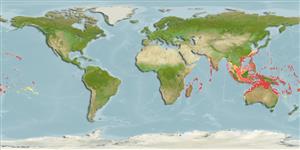Common names from other countries
分類 / Names
俗名 | 同種異名 | Catalog of Fishes(屬, 種) | ITIS | CoL | WoRMS | Cloffa
Environment: milieu / climate zone / depth range / distribution range
生態學
海洋 礁區魚類; 深度上下限 4 - 100 m (Ref. 6390). 熱帶; 30°N - 33°S, 33°E - 134°W (Ref. 5222)
Indo-Pacific: Kenya to Delagoa Bay, Mozambique, eastward to the Tuamoto Islands, north to the Ryukyu Islands, south to Queensland, Australia and including most islands of the Indian Ocean and of western and central Pacific. Unknown in the Red Sea and Persian Gulf. Misidentified as Plectropomus maculatus by some authors (Ref. 6448, 6892).
印度-太平洋: 肯亞到莫三比克的 Delagoa 灣, 向東至 Tuamoto 島, 北至琉球群島, 南至澳洲的昆士蘭省與印度洋與西太平洋與中太平洋的包括大多數的島嶼。 在紅海與波斯灣的未知。 被誤鑑成 斑鰓棘鱸〔Plectropomus maculatus〕 被一些作者了。 (參考文獻 6448,6892)
Length at first maturity / 大小 / 重量 / 年齡
Maturity: Lm ?, range 60 - ? cm
Max length : 125 cm TL 雄魚/尚未辨別雌雄; (Ref. 30573); common length : 84.0 cm SL 雄魚/尚未辨別雌雄; (Ref. 37816); 最大體重: 24.2 kg (Ref. 40637)
背棘 (總數): 7 - 8; 背的軟條 (總數): 10-12; 臀棘 3; 臀鰭軟條: 8.
A voracious piscivore inhabiting coral-rich areas of lagoon and seaward reefs. Encountered most frequently in channels and outer shelf reefs. Migrate over short distances to spawn, forming large aggregations, maybe 1 or 2 per reef (Ref. 6390). Feeds mostly on fishes, and occasionally on crustaceans (Ref. 9710). The prey comprises a variety of large reef fishes, including groupers, and this diet of large fishes is responsible for the high concentrations of ciguatera toxins. Juveniles may mimic the pufferfish Canthigaster valentini. Usually wary (Ref. 9710). The young have a demersal existence in shallow water in reef habitats, especially around coral rubble (Ref. 27259). They feed on small fish and invertebrates such as crustaceans and squid (Ref. 27261). Eggs float just below the surface (Ref. 6390). The pelagic larvae are found in habitats similar to those of the adults (Ref. 27260). An excellent table fish (Ref. 6390).
一個貪食的魚食動物居住於潟湖與臨海礁石的珊瑚礁繁盛區域。 常見於峽道與外部的大陸棚礁了。 短距離上移動產卵, 形成大的群集, 也許每礁 1 或 2.(參考文獻 6390) 大部份捕食魚, 與偶然地吃甲殼動物.(參考文獻 9710) 獵物包含多種大的珊瑚礁魚類,包括鱸科魚類,而且大魚的這一個食性是雪卡魚毒毒素的高集中的原因。 稚魚會擬態河魨 瓦氏尖鼻魨〔Canthigaster valentini〕 。 通常小心的.(參考文獻 9710) 幼魚有一個在礁石棲地中的淺水區中的底棲生存, 尤其在珊瑚殘礫周圍.(參考文獻 27259) 他們吃小魚與無脊椎動物例如甲殼動物與烏賊。 (參考文獻 27261) 卵飄浮緊鄰水面下。 (參考文獻 6390) 大洋性的仔魚被發現於棲息地類似那成魚的那些.(參考文獻 27260) 一個優良的食用魚.(參考文獻 6390)
Life cycle and mating behavior
成熟度 | 繁殖 | 產卵場 | 卵 | 孕卵數 | 仔魚
印度-太平洋: 肯亞到莫三比克的 Delagoa 灣, 向東至 Tuamoto 島, 北至琉球群島, 南至澳洲的昆士蘭省與印度洋與西太平洋與中太平洋的包括大多數的島嶼。 在紅海與波斯灣的未知。 被誤鑑成 斑鰓棘鱸〔Plectropomus maculatus〕 被一些作者了。 (參考文獻 6448,6892)
Heemstra, P.C. and J.E. Randall, 1993. FAO Species Catalogue. Vol. 16. Groupers of the world (family Serranidae, subfamily Epinephelinae). An annotated and illustrated catalogue of the grouper, rockcod, hind, coral grouper and lyretail species known to date. Rome: FAO. FAO Fish. Synop. 125(16):382 p. (Ref. 5222)
IUCN 瀕危狀態 (Ref. 130435)
無危 (LC) ; Date assessed: 21 November 2016
CITES (Ref. 128078)
Not Evaluated
人類使用
漁業: 商業性; 游釣魚種: 是的
更多資訊
參考文獻養殖養殖資訊品種遺傳學Electrophoreses遺傳率疾病加工Mass conversion
工具
特別的報告
下載 XML
網路資源
Estimates based on models
Preferred temperature (Ref.
115969): 25.5 - 28.9, mean 27.6 (based on 276 cells).
Phylogenetic diversity index (Ref.
82804): PD
50 = 0.5078 [Uniqueness, from 0.5 = low to 2.0 = high].
Bayesian length-weight: a=0.01000 (0.00609 - 0.01643), b=3.07 (2.93 - 3.21), in cm Total Length, based on LWR estimates for this species & (Sub)family-body (Ref.
93245).
營養階層 (Ref.
69278): 4.1 ±0.57 se; based on food items.
回復力 (Ref.
120179): 中等的, 族群倍增時間最少 1.4 - 4.4年 (Preliminary K or Fecundity.).
Fishing Vulnerability (Ref.
59153): High vulnerability (61 of 100).
